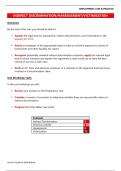EMPLOYMENT LAW & PRACTICE
INDIRECT DISCRIMINATION/HARRASSMENT/VICTIMISATION
Outcomes
By the end of this unit, you should be able to:
✓ Explain the legal tests for harassment, indirect discrimination, and victimisation in the
Equality Act 2010.
✓ Advise an employer of the appropriate steps to take to minimise exposure to claims of
harassment and other Equality Act claims.
✓ Recognise potentially unlawful indirect discrimination scenarios, apply the relevant legal
tests to those scenarios and explain the arguments a client could use to have the best
chance of success in each case.
✓ Draft an ET1 form and advise an employer or a claimant on the legal and practical issues
involved in a discrimination claim.
Unit Workshop Tasks
In this unit workshop you will:
✓ Review your answers to the Preparatory Task.
✓ Consider a number of scenarios to determine whether there are any possible claims of
indirect discrimination.
✓ Progress the Hilary Baker case study.
Contents
Indirect Discrimination 2
Vicarious Liability 8
Harassments 9
Victimisation 12
not for resale or distribution
, EMPLOYMENT LAW & PRACTICE
INDIRECT DISCRIMINATION
Ch10 p433
❖ Indirect discrimination under s19 of the Equality Act 2010 occurs where an employer:
o Applies a provision, criterion, or practice (PCP) which:
▪ Puts workers sharing a protected characteristic
▪ At a particular disadvantage
▪ As compared with workers who do not possess that characteristic.
s19 of the Equality Act
(1) A person (A) discriminates against another (B) if A applies to B a provision, criterion or
practice which is discriminatory in relation to a relevant protected characteristic of B’s.
(2) For the purposes of subsection (1), a provision, criterion or practice is discriminatory in
relation to a relevant protected characteristic of B’s if—
(a) A applies, or would apply, it to persons with whom B does not share the
characteristic
(b) it puts, or would put, persons with whom B shares the characteristic at a particular
disadvantage when compared with persons with whom B does not share it,
(c) it puts, or would put, B at that disadvantage, and
(d) A cannot show it to be a proportionate means of achieving a legitimate aim.
❖ There are four requirements:
1. There must be a “provision, criterion or practice” PCP:
▪ This must be applied equally to everyone within the relevant group
including the particular worker.
2. The PCP must put, or would put, people who share the worker’s protected
characteristic at a particular disadvantage when compared with people who do
not have that characteristic.
3. The PCP must put, or would put, that particular worker at a disadvantage.
4. The employer cannot show that the PCP is a proportionate means of achieving a
legitimate aim.
not for resale or distribution
, EMPLOYMENT LAW & PRACTICE
Elements of an indirect discrimination claim:
- Claimant must first show that he belongs to a particular protected group
- Must show that he is put to the disadvantage to which the protected group to which he
belongs is put
- A provision, criterion, or practice (PCP) must then be identified which is applied to the
claimant and has or would have an adverse impact on the claimant.
o PCP must be neutral – if it is premised on the rule that is itself discriminatory, the
claim is likely to be one of direct discrimination, James v Eastleigh Borough Council
[1990] ICR 554
- The ONLY DEFENCE to indirect discrimination claim is justification.
o The application of the PCP constituted a proportionate means of achieving a
legitimate aim.
Eligibility ❖ The Act protects both “workers” and “employees” (s83):
o Employees (s39)
▪ s83(2): defines ‘Employment’ as “employment under a contract
of employment, a contract of apprenticeship or a contract
personally to do work”.
o Job applicants (s39)
o Contract workers (s41)
o Office holders (s50)
o Trade union members (s50)
o Employees whose employment has ended (s108).
❖ No length of service requirement.
Time Limit ❖ 3 months (LESS A DAY) from the date of the unlawful act (s123(1)).
❖ The Tribunal has discretion to extend the time period if it thinks it “just and
equitable” (s123(1)(b)).
What is the s19(3) provides the following protected characteristics:
relevant
Protected ❖ Age (s5)
Characteristic? ❖ Gender reassignment (s7)
o I.e., someone who is proposing to undergo, has undergone, or is
(s19(3)). undergoing gender reassignment.
o Includes transsexuals (s7(2)) [someone who identifies as belonging
to the opposite sex]- “a reference to a transsexual person is a
reference to a person who has the protected characteristic of gender
reassignment”.
❖ Marriage and civil partnership (s8).
❖ Race (s9)
o Includes “colour”, “nationality, “ethnic or national origins” (s9(1)(a)-
(b)).
❖ Religion or belief (s10).
not for resale or distribution




